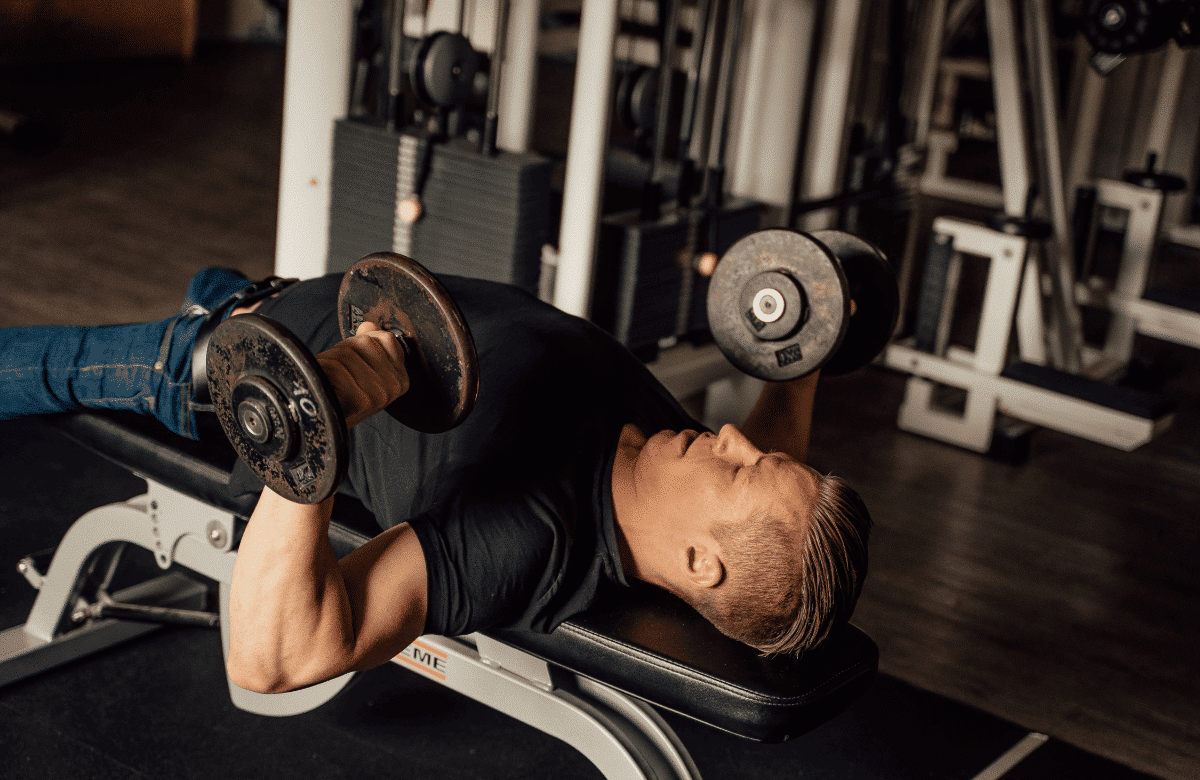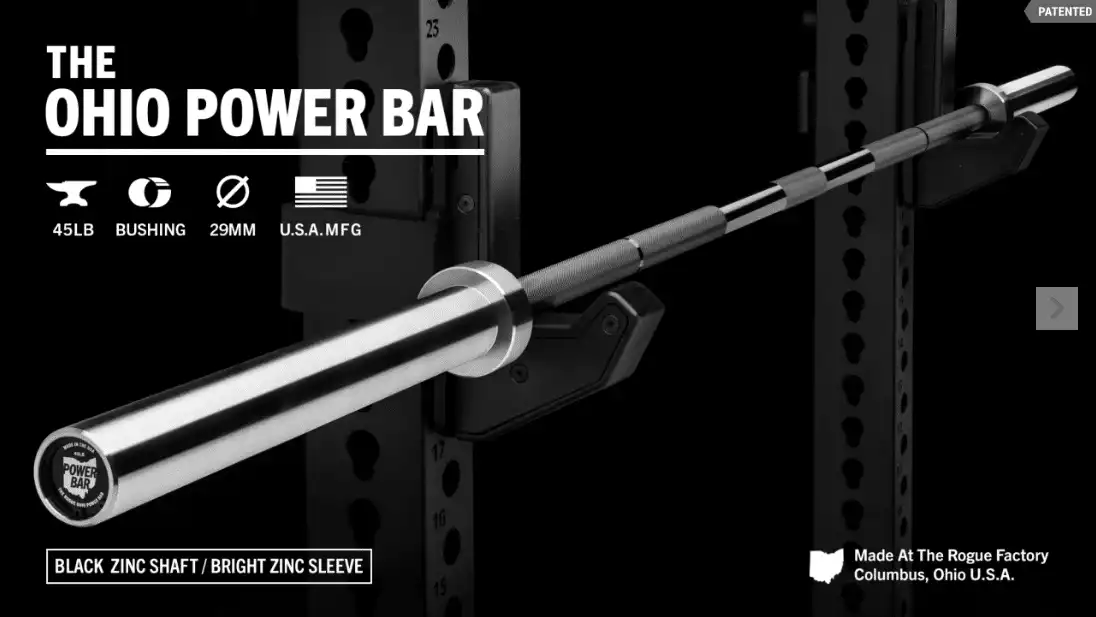Want a ripped, sculpted chest? It’s time to focus on your inner chest muscles.
This complete guide will show you how! We’ll break down the science of chest muscle function and introduce you to the best inner chest exercises.

-
Save
Get ready to transform your workouts and build that defined chest you’ve always wanted.
Jump to:
How the Chest Muscles Work
Before we dive into the best exercises for targeting your inner chest, it’s essential to grasp the fundamentals of how the pectoral muscles function. The chest muscles, or pectoralis major, consist of two main heads: the clavicular head (upper chest) and the sternocostal head (lower chest).
To target the inner chest, it’s essential to do exercises with a wide range of motion to ensure that all muscle fibers are targeted. The inner chest lies beneath both portions and is crucial for achieving a balanced and sculpted chest.
When you perform chest workouts, it’s vital to target these muscles effectively throughout their entire range of motion. This not only activates more muscle fibers but also ensures that you’re getting the most out of your training sessions.
Top 6 Inner Chest Workout Exercises
To achieve a balanced physique and maximize your chest gains, it’s crucial to incorporate a variety of exercises that hit different angles and muscle fibers within the chest. In this section, we’ll cover a range of exercises and training techniques designed to help you sculpt a formidable chest from every angle.
Flat Bench Press
The flat bench press is a versatile cornerstone of any chest routine, offering numerous advantages that extend to the entire upper body. It primarily targets the pectoral muscles, engaging both the clavicular and sternocostal heads, while also involving the anterior deltoids, triceps, and shoulder stabilizers.
Furthermore, the flat bench press allows for muscle isolation, particularly in the inner chest, contributing to that coveted separation between pectoral muscles. Its adaptability makes it suitable for various training goals, from hypertrophy to raw strength, saving time while delivering a comprehensive upper-body workout.
Incorporating the flat bench press into your chest routine not only fosters a well-defined chest but also bolsters overall upper-body strength, muscle engagement, and stability. It remains a fundamental exercise that efficiently targets multiple muscle groups, making it an indispensable component of any well-rounded training regimen.
How to Do It:
1. Lie on a flat bench with your feet flat on the ground.
2. Grip the barbell with a comfortable, neutral grip.
3. Lower the barbell to your chest, allowing your elbows to flare out slightly.
4. Push the barbell back up to the starting position.
You want to do this exercise but don’t want to go to the gym? You can set up your own home gym. You’ll need a powerlifting barbell (which can also be used for squats and deadlifts). In our detailed guide on the best powerlifting barbells, we ranked the Rogue Ohio model at number 1, because of its superb versatility and sturdiness. It can be a major asset to your training.
The Rogue Ohio Power Bar is regarded as an exceptional power bar for daily powerlifting. It is ideal for squatting, benching, and deadlifting.
Dumbbell Bench Press
The dumbbell bench press is a versatile and highly effective exercise that offers a range of benefits for your chest development. One of its primary advantages lies in its ability to engage and isolate separate muscle fibers within your pectoral muscles.
While compound exercises like the barbell bench press work well for overall chest development, the dumbbell bench press shines in its capacity to target and stimulate specific regions, making it an ideal choice for those seeking to emphasize their inner or middle chest during their workout routine.
When it comes to middle chest exercises, the dumbbell bench press is a standout performer. It places a significant focus on the middle portion of your chest, encouraging the growth and definition of the pectoral muscles in this area. This targeted middle chest workout is particularly beneficial for individuals aiming to achieve a more balanced and aesthetically pleasing chest appearance. By stimulating the muscle fibers in the middle chest, you can create a well-defined and sculpted chest that complements your overall physique.
How to Do It:
1. Lie on a flat bench with a dumbbell in each hand, palms facing forward.
2. Lower the dumbbells to your chest while keeping your elbows at a 90-degree angle.
3. Push the dumbbells back up to the starting position.
Dumbbell Chest Fly
The dumbbell chest fly is a classic exercise that’s ideal for targeting the entire chest, including the inner pectoral muscles. Unlike pressing movements like the bench press, which primarily engage the triceps and shoulders, the chest fly emphasizes the stretching and contracting of the chest muscles, making it an excellent choice for inner chest development.
The primary benefit of the dumbbell chest fly is its ability to provide a deep stretch and contraction in the chest muscles. When performed correctly, this exercise can help isolate and activate the inner chest, promoting growth and definition. Adding it to your routine can enhance the overall balance and aesthetics of your chest.
How to Do It:
- Lie on a flat bench with a dumbbell in each hand, extended above your chest.
- Your palms should be facing each other, and your elbows slightly bent.
- Begin by lowering your arms in a wide arc, maintaining a slight bend in your elbows.
- As you lower the dumbbells, focus on feeling a stretch in your chest muscles.
- Once you reach a comfortable stretch, reverse the motion, bringing the dumbbells back to the starting position.
- Squeeze your chest muscles as you bring the dumbbells together above your chest.
Cable Flyes
Cable flyes are a versatile exercise with numerous benefits that can significantly enhance your chest day routine. One of the primary advantages of cable flyes is their exceptional chest activation potential. Unlike many other chest exercises, cable flyes allow you to maintain constant tension on your chest muscles throughout the entire range of motion. As you bring your hands together at chest level during the exercise, you’ll experience an intense contraction in the chest region, emphasizing the inner chest.
Furthermore, cable flyes offer versatility in terms of adjusting the height and angle of the pulleys, allowing you to vary the angle of chest engagement. By performing cable flyes from different positions, you can effectively target various portions of the chest, ensuring a well-rounded development. Overall, the comprehensive chest activation, adjustability, and emphasis on the inner chest region make cable flyes an indispensable addition to any chest workout routine.
How to Do It:
1. Set the cables at shoulder height on a cable machine.
2. Stand in the center, hold a handle in each hand, and step forward slightly.
3. Maintain a neutral grip as you bring your hands together in a hugging motion.
4. Squeeze your inner chest at the end of the motion, then return to the starting position.
Hex Press
The hex press is a variation of the bench press that specifically emphasizes the inner chest. It involves the use of dumbbells and a flat bench, much like a traditional bench press. However, there’s a twist—literally. Instead of pressing the dumbbells vertically, you’ll rotate them slightly inward, so they resemble a hexagon or “hug” shape. This small adjustment in hand positioning can make a world of difference in targeting the inner chest.
The key to the hex press’s effectiveness lies in its ability to isolate the inner pectoral muscles. By angling the dumbbells inward, you shift the focus of the exercise to the center of your chest, forcing these muscles to engage more intensely. This isolation is precisely what makes the hexpPress an excellent addition to your inner chest workout.
How to Do It:
- Lie flat on a bench with your feet planted firmly on the ground. Hold a dumbbell in each hand with an overhand grip.
- Start with the dumbbells positioned just above your chest, palms facing each other.
- Lower the dumbbells slowly and under control, allowing them to move towards the center of your chest.
- As you press the dumbbells back up, focus on squeezing your inner chest muscles.
- Exhale as you push the dumbbells upward, fully extending your arms without locking your elbows.
Push-Ups
Push-ups are a classic bodyweight exercise that not only strengthen your chest but also provide an excellent opportunity to target your inner pectoral muscles. This fundamental exercise requires no equipment and can be performed virtually anywhere.
Push-ups are versatile and can be modified to suit your fitness level. When performed correctly, they engage your entire chest, with a special focus on the inner chest. The combination of gravity and bodyweight resistance creates a natural inward-squeezing motion, making it an effective exercise for inner chest development.
How to Do It:
- Begin in a plank position with your hands placed slightly wider than shoulder-width apart.
- Keep your body in a straight line from head to heels, engaging your core muscles.
- Lower your chest towards the ground by bending your elbows, keeping them close to your sides.
- As you descend, focus on squeezing your inner chest muscles.
- Push back up to the starting position, fully extending your arms without locking your elbows.
Variations:
Push-ups offer various progression options to challenge yourself and continually stimulate inner chest growth:
- Diamond Push-Ups: Place your hands close together beneath your chest in a diamond shape to intensify inner chest activation.
- Incline Push-Ups: Elevate your hands on a bench or sturdy surface to target the upper chest and inner pecs.
- Decline Push-Ups: Elevate your feet on a bench or step to emphasize the lower chest and inner pectoral muscles.
Training Tips for Inner Chest Workout
To maximize your inner chest muscle activation and promote muscle growth, follow these training tips:
Maintain a Neutral Grip
Maintaining a neutral grip during your chest exercises is a fundamental technique that deserves a closer look. This hand position, where your palms face each other or are in a comfortable, parallel alignment, has several important benefits.
First and foremost, a neutral grip reduces the strain on your shoulder joints. By aligning your wrists and elbows in a more natural and anatomically sound manner, it minimizes the risk of overextension or awkward angles that can lead to shoulder discomfort or injury over time. This ergonomic positioning allows for smoother and safer movement, especially during heavy lifting, where proper form is critical to prevent injury.
Focus on Time Under Tension
Focusing on Time Under Tension (TUT) during your chest workouts can profoundly impact the effectiveness of your muscle-building efforts. TUT refers to the duration your muscles are actively engaged or under load during each repetition of an exercise. By extending this period strategically, you introduce a novel stimulus to your muscle fibers, stimulating them to adapt and grow.
Incorporating longer TUT into your chest exercises entails executing both the concentric (muscle-shortening) and eccentric (muscle-lengthening) phases deliberately and slowly. This deliberate pace increases the duration your muscle fibers are exposed to tension, which is a critical factor for muscle hypertrophy.
It also amplifies the metabolic stress placed on the muscle, triggering the release of growth-promoting hormones and creating micro-tears that, when repaired, result in increased muscle size and strength.
Compound Exercises
Compound exercises, often referred to as multi-joint movements, are a fundamental cornerstone of effective strength training and bodybuilding. What sets compound exercises apart is their ability to engage multiple muscle groups and joints simultaneously during a single movement. This unique feature makes them highly efficient for achieving a wide range of fitness goals, including muscle gain, fat loss, and functional strength improvement.
One of the key advantages of compound exercises is their ability to mimic real-world movements, making them highly functional. When you perform compound movements like the deadlift, squat, or bench press, you’re essentially replicating actions you might encounter in daily life or sports activities. This functional carryover is invaluable because it not only builds strength but also enhances your ability to perform everyday tasks with ease.
Proper Range of Motion
Proper range of motion is a fundamental aspect of any effective strength training regimen. It refers to the complete movement that a joint or muscle group can undergo during an exercise. In the context of chest workouts, adhering to the correct range of motion ensures that you are maximizing the engagement of your pectoral muscles and reaping the full benefits of each repetition. When you perform chest exercises, allowing the weights to descend until they lightly touch your chest, without bouncing, is essential.
Proper range of motion also extends to the concentric phase of the exercise, where you fully extend your arms or push the weights back to the starting position. This attention to detail is crucial for promoting muscle growth, enhancing strength, and avoiding potential imbalances or joint issues that can arise from incomplete or erratic movements. In essence, incorporating the correct range of motion into your chest workouts is about doing it right, ensuring that each repetition contributes to your long-term progress and overall fitness.
FAQ
How often should I train my inner chest?
You can target your inner chest 1-2 times per week as part of your overall chest workout routine. Remember to provide adequate rest between sessions for muscle recovery and growth.
Can I reduce chest fat with inner chest exercises?
Spot reduction is a myth, and you cannot target fat loss in specific areas of your body. A well-balanced workout routine and a healthy diet are key to reducing overall body fat, including chest fat.
How heavy should I lift for inner chest development?
Incorporate both heavy weights for lower rep ranges (e.g., 4-6 reps) and moderate weights for higher rep ranges (e.g., 10-15 reps) in your chest workouts. This variety will help stimulate muscle growth effectively.
Can I perform inner chest exercises with shoulder joint issues?
If you have shoulder joint issues, it’s essential to consult a healthcare professional or a certified trainer to determine which exercises are safe for you. In some cases, modifying exercises or using machines may be recommended to reduce strain on the shoulders.
What’s the role of the rib cage in inner chest development?
The rib cage provides structural support for the pectoral muscles and influences the range of motion during chest exercises. Pay attention to proper form and breathing to maximize your chest muscle activation while respecting the rib cage’s natural movement.
Share via:














